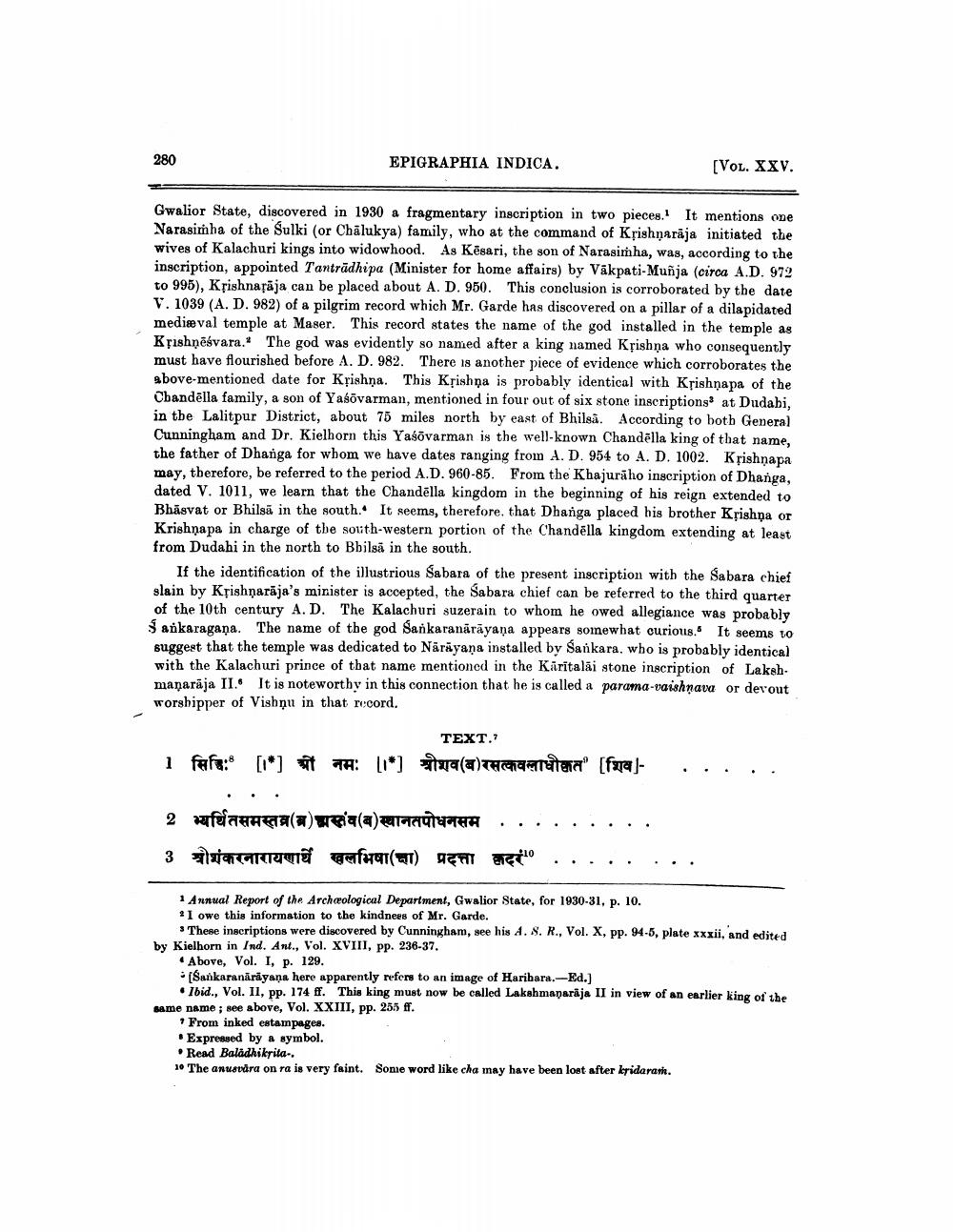________________
280
EPIGRAPHIA INDICA.
[Vol. XXV.
Gwalior State, discovered in 1930 a fragmentary inscription in two pieces. It mentions one Narasirha of the Sulki (or Chalukya) family, who at the command of Krishnaraja initiated the wives of Kalachuri kings into widowhood. As Kēsari, the son of Narasimha, was, according to the inscription, appointed Tantrādhipa (Minister for home affairs) by Vákpati-Muñja (circa A.D. 972 to 995), Krishnaraja can be placed about A. D. 950. This conclusion is corroborated by the date V. 1039 (A. D. 982) of a pilgrim record which Mr. Garde has discovered on a pillar of a dilapidated medieval temple at Maser. This record states the name of the god installed in the temple as Krishņēgvara.* The god was evidently so named after a king named Krishna who consequently must have flourished before A. D. 982. There is another piece of evidence which corroborates the above-mentioned date for Křishna. This Kļishna is probably identical with Krishnapa of the Cbandēlla family, a son of Yaśõvarman, mentioned in four out of six stone inscriptions at Dudabi, in the Lalitpur District, about 75 miles north by east of Bhilsa. According to both General Cunningham and Dr. Kielhorn this Yaśõvarman is the well-known Chandēlla king of that name, the father of Dhanga for whom we have dates ranging from A. D. 954 to A. D. 1002. Krishnapa may, therefore, be referred to the period A.D. 960-85. From the Khajuraho inscription of Dhanga, dated V. 1011, we learn that the Chandēlla kingdom in the beginning of his reign extended to Bhāsvat or Bhilsă in the south. It seems, therefore, that Dhanga placed his brother Krishpa or Krishnapa in charge of the south-western portion of the Chandēlla kingdom extending at least from Dudahi in the north to Bbilsă in the south.
If the identification of the illustrious Sabara of the present inscription with the Sabara chief slain by Kțishnarāja's minister is accepted, the Sabara chief can be referred to the third quarter of the 10th century A.D. The Kalachuri suzerain to whom he owed allegiance was probably S ankaragana. The name of the god Sankaranārāyaṇa appears somewhat curious. It seems to suggest that the temple was dedicated to Nārāyaṇa installed by Sankara, who is probably identical with the Kalachuri prince of that name mentioned in the Karitalāi stone inscription of Laksh. manarāja II. It is noteworthy in this connection that he is called a parama-vaishnava or devout worshipper of Vishnu in that record.
TEXT.)
(altho
1 faf
at TTA:
1)
utena" [fa]-
...
..
2 szfahar(W) xreia(a)alTautaha ......... 3 CORTOUT ofHat(T) OCH ET .....
.
1 Annual Report of the Archeological Department, Gwalior State, for 1930-31, p. 10. * I owe this information to the kindness of Mr. Garde.
These inscriptions were discovered by Cunningham, see his 4.8. R., Vol. X, pp. 94-5, plate xxxii, and edited by Kielhorn in Ind. Ant., Vol. XVIII, pp. 236-37.
. Above, Vol. I, p. 129.
Sankaranarayana here apparently refers to an image of Haribara.-Ed.)
• Ibid., Vol. II, pp. 174 ff. This king must now be called Lakshmadaraja II in view of an earlier king of the same name ; see above, Vol. XXIII, pp. 255 ff.
From inked estampages. • Expressed by a symbol.
Read Baladhikrita-, 10 The anusvåra on ra is very faint. Some word like cha may have been lost after kridaran.




